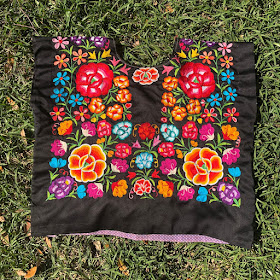I love huipiles...you know those tops originally from Guatemala and Mexico that can be elaborately embroidered. They are created from a flat piece of cloth and thus are an easy "canvas" for creativity.
The V & A has a fabulous article on huipiles, the colonial style Mexican blouse, and rebozos. According to this article the concept for the huipil, from Mexico and Guatemala, has "evolved" over 2,000 years. Originally it would have been backstrap woven and would have been created from one or two wide strips of clothing. Designs could be woven into the cloth.
This blog post, an interesting fashion read on what people of mixed race wore in 18th century Mexico, shows a woman wearing a huipil in Frame No. 7.
I visited the Museo de Trajes in Bogata in 2017; here is a photo of a Mexican huipil fragment that I took there, note the beautiful pickup woven inlays
Here is one that I purchased at Frida Kahlo Museum in the museum shop (Frida culture has popularized huipiles). It is of muslin, the width is just over 24 inches, with the selvedges used so that the arm holes did not need finishing.
Here is one I purchased in San Miguel d' Allende, but it is a special use of the huipil execution called "tejuana." Tehuana dress originated among indigenous Zapotec women on the Isthmus of Tehuantepec, in Oaxaca. This one is on satin with a cotton cloth lining. The colors and handwork are exquisite with most all the work done in chain stitch. I think all colors look better on black; it provides a wonderful contrast. In the article from the V & A above, there is a photo of women from Tehuana dressed similarly for a religious celebration.
The V & A has a fabulous article on huipiles, the colonial style Mexican blouse, and rebozos. According to this article the concept for the huipil, from Mexico and Guatemala, has "evolved" over 2,000 years. Originally it would have been backstrap woven and would have been created from one or two wide strips of clothing. Designs could be woven into the cloth.
This blog post, an interesting fashion read on what people of mixed race wore in 18th century Mexico, shows a woman wearing a huipil in Frame No. 7.
I visited the Museo de Trajes in Bogata in 2017; here is a photo of a Mexican huipil fragment that I took there, note the beautiful pickup woven inlays
Here is one that I purchased at Frida Kahlo Museum in the museum shop (Frida culture has popularized huipiles). It is of muslin, the width is just over 24 inches, with the selvedges used so that the arm holes did not need finishing.
Here is one I purchased in San Miguel d' Allende, but it is a special use of the huipil execution called "tejuana." Tehuana dress originated among indigenous Zapotec women on the Isthmus of Tehuantepec, in Oaxaca. This one is on satin with a cotton cloth lining. The colors and handwork are exquisite with most all the work done in chain stitch. I think all colors look better on black; it provides a wonderful contrast. In the article from the V & A above, there is a photo of women from Tehuana dressed similarly for a religious celebration.
Here is another purchased on ebay. It is on blue velvet, again with a cotton cloth lining.
If you are interested in sewing or embroidering/creating one of your own, the Victoria and Albert Museum recently had an exhibit entitled "Frida Kahlo: Making Herself Up" which showed Frida's clothing and personal artifacts, including this
Here is Frida in a huipil in New York City, photo by Nicholas Muray, one of her lovers.
The V&A has a pattern for a huipil which is available online, with options for a round or a square neck. The pattern was developed by Alice & Co Patterns.
Interestingly, as part of this year's Quilt National, there is a class in using a shirt to tell a story; the basic template is a huipil. Here is the basic pattern at this website.
And...as long as we are talking Mexico, here is a wonderful song to hum along with as you sew, featuring the fabulous Natalia Lafourcade along with Emmanuel Del Real, a clip from a great movie,"Hecho en Mexico." Natalia has been known to adorn herself with beautiful traditional-inspired Mexican clothing.









No comments:
Post a Comment